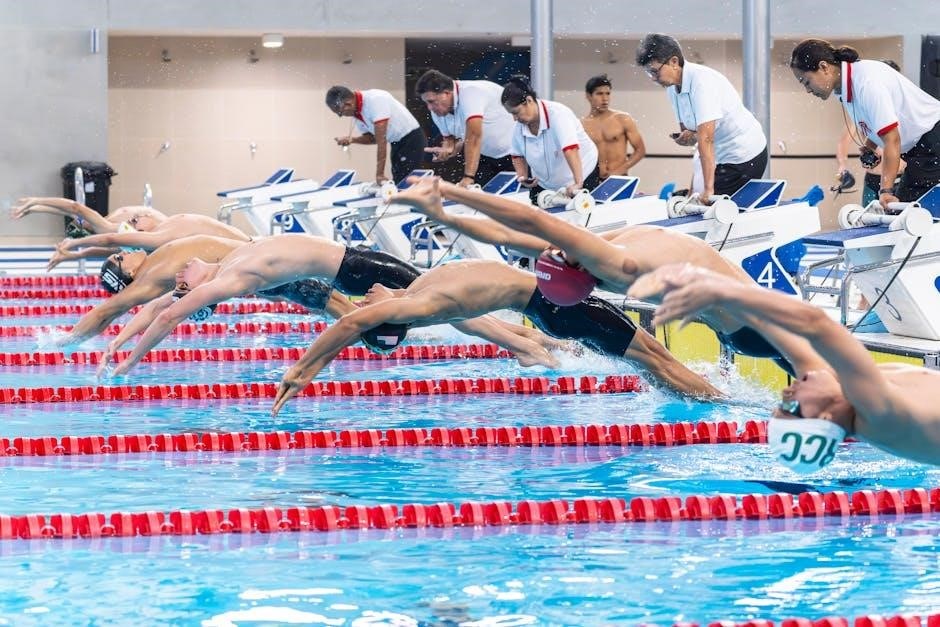Triphasic Training: A Comprehensive Overview
Triphasic training is a systematic approach‚ detailed in manuals and ebooks by Cal Dietz and Ben Peterson. It focuses on eccentric‚ isometric‚ and concentric phases. This method aims to develop elite speed and explosive strength‚ improving athletic performance.
What is Triphasic Training?
Triphasic training‚ as outlined in Cal Dietz’s manuals‚ represents a comprehensive method for developing athletic prowess. It strategically targets the three distinct phases of muscle action: eccentric (lengthening)‚ isometric (static)‚ and concentric (shortening). By emphasizing each phase through specific exercises and loading parameters‚ triphasic training aims to optimize force production‚ power output‚ and overall athletic performance. This approach‚ detailed in resources like the “Triphasic Training Baseball Speed and Strength E-Manual‚” seeks to maximize an athlete’s potential by holistically addressing the mechanical properties of muscle contraction and improving reactive strength.

The Core Principles of Triphasic Training
The core of triphasic training involves strategically emphasizing eccentric‚ isometric‚ and concentric phases of movement. This systematic approach optimizes athletic performance by enhancing force absorption‚ isometric strength‚ and explosive power development in athletes.
Eccentric Phase Emphasis
The eccentric phase‚ crucial in triphasic training‚ focuses on controlled muscle lengthening under load. Training this phase enhances the body’s ability to absorb and decelerate force efficiently. Emphasizing eccentric movements can lead to improved reactive strength and reduced risk of injury. Athletes learn to manage high-intensity stress during eccentric contractions‚ building a foundation for explosive power. This phase prepares the muscles for the subsequent isometric and concentric actions‚ optimizing the stretch-shortening cycle. Eccentric training enhances force production and overall athletic performance‚ making it a key component of the triphasic method.
Isometric Phase Emphasis
The isometric phase‚ a critical component of triphasic training‚ involves sustaining muscle contractions without any change in muscle length. This phase enhances the ability to generate maximal force at a specific joint angle. Isometric training promotes neural adaptations‚ improving muscle activation and coordination. By emphasizing isometric holds‚ athletes can enhance their stability and control during movements. This training phase also helps in developing strength at specific points in the range of motion‚ reducing the risk of injury and enhancing overall athletic performance. Integrating isometric exercises strengthens tendons and ligaments‚ increasing resilience and power output.
Concentric Phase Emphasis
The concentric phase‚ the final stage of triphasic training‚ focuses on the shortening of the muscle to produce movement. This phase emphasizes explosive power and the ability to generate force rapidly. Concentric training involves exercises where the athlete actively lifts or pushes against resistance‚ building strength through dynamic movement. By prioritizing concentric contractions‚ athletes improve their ability to accelerate and generate high levels of power. This phase aims to enhance the speed and efficiency of muscle fiber recruitment‚ leading to improved athletic performance and increased overall muscle power output‚ crucial for sports requiring explosive movements.

Benefits of Triphasic Training
Triphasic training offers enhanced explosive strength‚ improved athletic performance‚ and reduced injury risk. Integrating eccentric‚ isometric‚ and concentric phases optimizes muscle function and power output‚ benefiting athletes across various sports.
Improved Athletic Performance
Triphasic training significantly boosts athletic performance by focusing on the three phases of muscle action: eccentric‚ isometric‚ and concentric. This approach enhances force absorption‚ stability‚ and power generation‚ leading to improvements in speed‚ agility‚ and overall athleticism. Athletes can experience greater efficiency in movement patterns‚ allowing them to perform at higher intensities for longer durations. The method helps maximize oxygen intake‚ optimize metabolite clearance‚ and improve reaction time. By improving these key areas‚ triphasic training creates a more well-rounded and capable athlete‚ achieving superior results in their respective sports.
Enhanced Explosive Strength and Power
Triphasic training is designed to dramatically enhance explosive strength and power through targeted training of each muscle action phase. By emphasizing eccentric loading‚ the body learns to absorb and decelerate force more effectively‚ leading to greater power output during the concentric phase. Isometric holds build strength at specific joint angles‚ improving stability and force production. This comprehensive approach optimizes the stretch-shortening cycle‚ enabling athletes to generate more force in less time. Ultimately‚ triphasic training transforms athletes into more explosive and powerful performers‚ enabling them to excel in activities requiring rapid and forceful movements.

Triphasic Training Application
Triphasic training is applied through structured models like block training‚ focusing on accumulation‚ transmutation‚ and realization. Modified undulating training also integrates triphasic principles‚ optimizing athletic performance and preventing injuries through varied stimuli.
Block Training Model
The block training model is a key application of triphasic training‚ dividing the training cycle into distinct blocks‚ each with a specific focus. These blocks typically include accumulation‚ transmutation‚ and realization phases. The accumulation phase emphasizes building a base level of strength and conditioning. The transmutation phase transitions the accumulated strength into power. Finally‚ the realization phase optimizes performance for competition. This structured approach allows athletes to peak multiple times per year. Block training‚ as outlined by Dietz‚ helps athletes achieve superior results by sequentially developing specific athletic qualities‚ ensuring readiness for key performance events.
Modified Undulated Training
Modified undulated training represents a dynamic approach to triphasic training‚ offering variability within shorter training cycles. Unlike the block model‚ this method involves fluctuating the emphasis on eccentric‚ isometric‚ and concentric phases on a more frequent basis‚ such as weekly or even daily. This approach‚ discussed in various triphasic training resources‚ helps prevent accommodation and continuously challenges the neuromuscular system. By alternating the focus‚ athletes can improve force absorption‚ isometric strength‚ and explosive power in a more integrated fashion. Modified undulation can be strategically implemented to address specific weaknesses or prepare for diverse athletic demands.
Triphasic Training Program Design
Triphasic training program design involves careful exercise selection and loading parameters. This approach emphasizes integrating eccentric‚ isometric‚ and concentric phases. This method is crucial for optimizing athletic performance and preventing injuries‚ as outlined in Cal Dietz’s resources.
Exercise Selection
Selecting appropriate exercises is paramount in triphasic training‚ focusing on movements that effectively target eccentric‚ isometric‚ and concentric muscle actions. Exercises should align with the athlete’s sport and training goals‚ promoting speed‚ power‚ and injury prevention. Compound movements like squats‚ pulls‚ and presses are often prioritized due to their ability to engage multiple muscle groups simultaneously. Furthermore‚ variations of these exercises can be used to emphasize specific phases of the triphasic model. Consider incorporating plyometrics and ballistic exercises to enhance explosive power output. The chosen exercises should facilitate high-speed‚ high-intensity movements‚ maximizing stress on the targeted muscle groups.
Loading Parameters
Careful manipulation of loading parameters is crucial within the triphasic training framework to optimize specific adaptations. Eccentric phases often involve supramaximal loading or accommodating resistance to enhance force absorption. Isometric phases may require extended durations at specific joint angles to maximize neural drive. Concentric phases typically utilize lighter loads with a focus on maximal velocity and intent. Implementing undulated loading models allows for weekly variation in intensity and volume across different qualities like strength and power. Employing the 13 loading zones can provide a systematic approach to planning various qualities throughout the training cycle. Spotting is crucial due to potential fatigue.
Triphasic Training for Different Sports
Triphasic training’s adaptable nature makes it applicable across various sports. Its focus on eccentric‚ isometric‚ and concentric phases allows customization. This is to meet the specific demands and movement patterns unique to each sport.
Baseball
Triphasic training offers substantial benefits for baseball players by enhancing speed‚ power‚ and overall athletic performance. The method’s emphasis on eccentric strength aids in deceleration during movements like pitching and fielding. Isometric training improves stability and control‚ crucial for hitting and throwing accuracy. Concentric training boosts explosive power for actions like sprinting‚ hitting‚ and throwing.
Integrating triphasic principles can lead to improved bat speed‚ throwing velocity‚ and running agility. This approach facilitates quicker reactions‚ enhanced power output‚ and reduced risk of injury‚ making it valuable for baseball athletes aiming to elevate their game.
Other Sports Applications
Beyond baseball‚ triphasic training’s principles are applicable across various sports demanding explosive power and agility. In basketball‚ it enhances jumping ability and rapid changes in direction. For soccer‚ it improves sprinting speed and kicking power. Football benefits from increased tackling force and explosive movements off the line.
In combat sports like wrestling and martial arts‚ triphasic training builds strength and stability for grappling and striking. Swimmers can gain power and efficiency in their strokes. Track and field athletes improve performance in sprinting‚ jumping‚ and throwing events. The method’s versatility makes it valuable across diverse athletic disciplines‚ optimizing performance.

Resources for Triphasic Training
Several resources exist for triphasic training‚ including manuals by Cal Dietz. These resources often come in PDF format‚ detailing training methods and program design for enhancing athletic performance through the triphasic approach.
Cal Dietz’s Triphasic Training Manuals (PDF)
Cal Dietz‚ renowned for his contributions to sports performance‚ has authored several triphasic training manuals available in PDF format. These manuals outline a systematic approach to developing speed and explosive strength. They delve into periodization principles and stress-based training‚ offering comprehensive guidance. Topics covered include block training models‚ modified undulated training‚ and triphasic muscle action. These manuals serve as valuable resources for coaches and athletes seeking to implement triphasic training methods. They provide insights into exercise selection‚ loading parameters‚ and program design‚ facilitating the application of triphasic principles to improve athletic capabilities and prevent injuries effectively.
